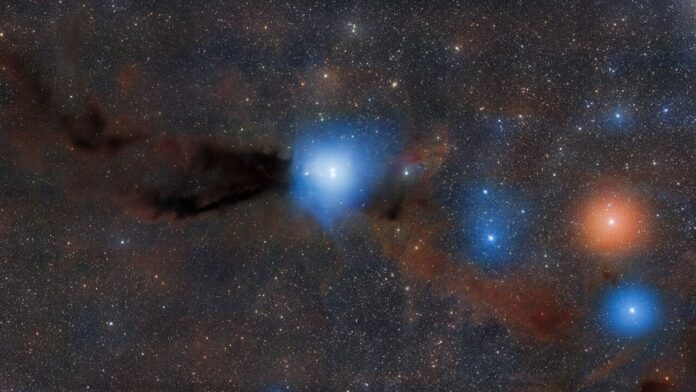Astronomers have witnessed two infant stars in a vast stellar nursery burst from their natal cribs of gas and dust. The newly formed stars, or “protostars,” are located at the heart of the massive star-birthing interstellar cloud called Lupus 3.
The observations of the heart of Lupus 3 were made with the Dark Energy Camera located at the Cerro Tololo Inter-American Observatory in Chile and could help shed more light on the mystery of star formation.
As they made their escape from the matter that helped form them, the protesters illuminated the reflection nebula Bernes 149. Reflection nebulas are clouds of interstellar dust that aren’t heated enough by light from surrounding stars to emit radiation on their own but can, as the name suggests, reflect light from these stars, becoming stunning cosmic beacons alerting astronomers to infant stars.
The blazing blue stars in Lupus 3, which is located around 500 light-years from Earth, are known as HR 5999 and HR 6000 and give Bernes 149 a bright blue aura. This is in stark contrast to the dark nebula of gas from which the stars were born, Lupus 3, which can be seen as an ominous black cloud in the Dark Energy Camera image.
Related: Cosmic monsters found lurking at heart of ancient star clusters by the James Webb Space Telescope
Though Lupus 3 is just one of at least nine clouds within the massive Lupus cloud complex, it still covers an area of the sky equivalent to 24 times the with of the moon. The Dark Energy camera is ideal for capturing views of such large objects in one image because it has a tremendously wide field of view.
Despite its dark-as-night appearance, Lupus 3 is actually hiding a whole family of protostars. These protostars, collectively known as the T Tauri stars, haven’t yet begun the nuclear fusion processes that define fully-fledged stars.
This will change as they gather mass from their gas and dust from Lupus 3, growing until they are massive enough to initiate fusion. After this, the T Tauri stars will also belt out bright blue light and erupt from their stellar nursery.
Despite their brightness and being developmentally ahead of their stellar nursery companions, neither HR 5999 nor HR 6000 are yet fully-fledged stars. At just around 1 million years old, they are still not powered by the fusion of hydrogen to helium that powers stars like our 4.6 billion-year-old sun.
The bright blue emissions of HR 5999 and HR 6000 are instead powered by the action of gravity compressing and heating internal matter. This has allowed them to blow away nearly all the gas and dust that once enshrouded them.
When astronomers first figured out that the blue glow of Bernes 149 was the reflection of young stars, they were confident that this could not only help them learn about star formation but could also point them to similar star-birthing regions. And as this new image shows, that hunch has been proved correct.
Follow us on Twitter @Spacedotcom and on Facebook.

